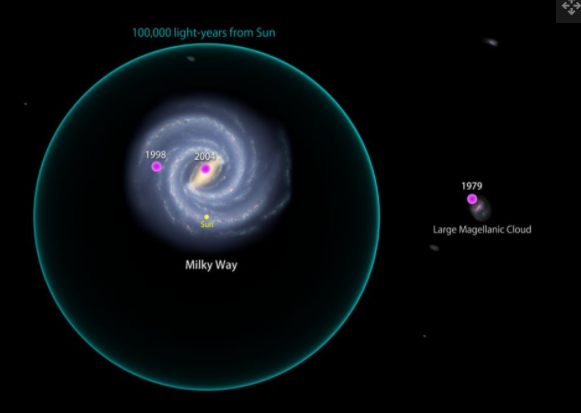Powerful cosmic eruptions traced to brilliant ‘magnetar’ in nearby galaxy

Astronomers may have captured the first good look at giant flares from the strongest magnets in the universe.
The likely cause of these giant flares? Starquakes trillions of trillions of times stronger than any earthquakes, scientists reported at the 237th American Astronomical Society meeting, held virtually last week.
The most powerful magnets in the cosmos are magnetars, which possess magnetic fields about 100 trillion times more powerful than Earth’s, or 10 trillion times that of an ordinary fridge magnet, Kevin Hurley, an astrophysicist at the University of California, Berkeley, said during a news conference held Jan. 13
Magnetars are a rapidly spinning kind of neutron star, which is a corpse of a star that died in a catastrophic explosion known as a supernova. “Magnetars are up to a thousand times more magnetic than ordinary neutron stars,” Soebur Razzaque, an astroparticle physicist at the University of Johannesburg and the senior author on one of the studies presented, said in a statement.
“In the Milky Way there are tens of thousands of neutron stars,” Razzaque added. “Of those, only 30 are currently known to be magnetars.”
Once magnetars are born, they only stay magnetars for about 10,000 years before their magnetic fields weaken to render them relatively ordinary neutron stars, Eric Burns, an astrophysicist at Louisiana State University and co-author of the new study, said at the press conference. Magnetars are typically seen in star-forming regions, such as starburst galaxies, he noted.
Related: Where do baby magnetars come from? Mysterious ‘fast radio bursts’ may provide clues.
Previous research discovered magnetars regularly explode with X-ray bursts about one-tenth of a second long that each pack up to about the same amount of energy the sun gives off in a year. In three instances over the past 40 years, astronomers have seen magnetars in the Milky Way and nearby galaxies explode with even brighter, more energetic outbursts of X-rays and gamma rays. However, such giant flares were so powerful, they blinded any sensors that glimpsed them, making them difficult to study in any great detail.
Now researchers may have the best look yet at a giant magnetar flare, one good enough to help them deduce its possible origins.
Scientists analyzed the extremely bright gamma-ray burst GRB 200415A, which five space observatories that form the so-called Interplanetary Network detected on April 15, 2020. Gamma-ray bursts are the most powerful kinds of explosions known in the universe, each giving off as much energy in milliseconds to minutes as the sun is expected to emit during its entire 10-billion-year lifetime.
At its peak, this newfound explosion was about 360 trillion times more luminous than the sun. “That is about 100,000 years of solar energy released in only 140 milliseconds,” Hurley said.
The Interplanetary Network triangulated the location of the gamma-ray burst to the center of the nearby Sculptor galaxy, formally known as NGC 253, which is located about 11.4 million light-years from Earth in the Sculptor constellation. Previously detected GRBs came from relatively far away from the Milky Way, but GRB 200415A originated much closer to home, in cosmic terms.
Gamma-ray bursts are typically divided into two groups — long and short — depending on whether they last more or less than two seconds. Short gamma-ray bursts are most likely caused by the mergers of neutron stars, while long gamma ray-bursts are linked with supernovas.
GRB 200415A lasted just 140 milliseconds, about the blink of an eye. “It’s as fast as snapping your fingers,” Oliver Roberts, an astrophysicist at the Universities Space Research Association in Huntsville, Alabama who led another new study on GRB 200415A, said at the news conference.
This speed would ordinarily suggest it was a short gamma-ray burst. However, the pattern of light seen from this outburst was very different from that seen from short gamma-ray bursts that previous research found were caused by colliding neutron stars.
Instead, GRB 200415A’s light pattern was a near copy of those previously seen from giant magnetar flashes. Those began with an intense flash about one-fifth of a second long, followed by a string of pulses lasting about two to 12 seconds.
The cause of this newfound giant magnetar flare was likely a “starquake” — a rupture of the magnetar’s solid crust, Roberts said. This quake was huge — magnitude 27.8 in strength, or about one thousand trillion trillion (10^27, or a 1 with 27 zeroes behind it) times more powerful “than the largest known terrestrial earthquake, which was the magnitude 9.5 [earthquake] in Chile in 1960,” Hurley said.
The researchers suggested this starquake not only released a bright flash of gamma rays, but also heated the magnetar’s crust. As the magnetar whirls around, this super-hot crust looks like a series of bright flashes that dim as the surface cools, Hurley told Space.com.
The scientists added this starquake likely also spit out a blob of plasma traveling about 99% the speed of light, Nicola Omodei, an astrophysicist at Stanford University who participated in the study, said at the press conference.
After four days, this blob encountered the shockwave created when the giant bubble of plasma around the magnetar, known as its magnetosphere, slammed into the interstellar medium of gas and dust between stars at a speed of about 2.2 million mph (3.6 million kph). When the blob collided with this shockwave, it generated another pulse of gamma rays seen 19 seconds after the initial flash. The gamma rays in this second outburst were even more energetic than those seen in the first one, he noted.
All in all, these new findings suggest that maybe a small percent of known short gamma-ray bursts are caused by giant magnetar flares, Burns said.
The scientists detailed their findings Jan. 13 at an online meeting of the American Astronomical Society meeting. Hurley, Roberts and their colleagues detailed their findings in two studies in the Jan. 14 issue of the journal Nature. Omedei and his colleagues detailed their findings online Jan. 13 in the journal Nature Astronomy. At its peak, this newfound explosion was about 360 trillion times more luminous than the sun. “That is about 100,000 years of solar energy released in only 140 milliseconds,” Hurley said.
The Interplanetary Network triangulated the location of the gamma-ray burst to the center of the nearby Sculptor galaxy, formally known as NGC 253, which is located about 11.4 million light-years from Earth in the Sculptor constellation. Previously detected GRBs came from relatively far away from the Milky Way, but GRB 200415A originated much closer to home, in cosmic terms.
Gamma-ray bursts are typically divided into two groups — long and short — depending on whether they last more or less than two seconds. Short gamma-ray bursts are most likely caused by the mergers of neutron stars, while long gamma ray-bursts are linked with supernovas.
GRB 200415A lasted just 140 milliseconds, about the blink of an eye. “It’s as fast as snapping your fingers,” Oliver Roberts, an astrophysicist at the Universities Space Research Association in Huntsville, Alabama who led another new study on GRB 200415A, said at the news conference.
This speed would ordinarily suggest it was a short gamma-ray burst. However, the pattern of light seen from this outburst was very different from that seen from short gamma-ray bursts that previous research found were caused by colliding neutron stars.
Instead, GRB 200415A’s light pattern was a near copy of those previously seen from giant magnetar flashes. Those began with an intense flash about one-fifth of a second long, followed by a string of pulses lasting about two to 12 seconds.
The cause of this newfound giant magnetar flare was likely a “starquake” — a rupture of the magnetar’s solid crust, Roberts said. This quake was huge — magnitude 27.8 in strength, or about one thousand trillion trillion (10^27, or a 1 with 27 zeroes behind it) times more powerful “than the largest known terrestrial earthquake, which was the magnitude 9.5 [earthquake] in Chile in 1960,” Hurley said.
The researchers suggested this starquake not only released a bright flash of gamma rays, but also heated the magnetar’s crust. As the magnetar whirls around, this super-hot crust looks like a series of bright flashes that dim as the surface cools, Hurley told Space.com.
The scientists added this starquake likely also spit out a blob of plasma traveling about 99% the speed of light, Nicola Omodei, an astrophysicist at Stanford University who participated in the study, said at the press conference.
After four days, this blob encountered the shockwave created when the giant bubble of plasma around the magnetar, known as its magnetosphere, slammed into the interstellar medium of gas and dust between stars at a speed of about 2.2 million mph (3.6 million kph). When the blob collided with this shockwave, it generated another pulse of gamma rays seen 19 seconds after the initial flash. The gamma rays in this second outburst were even more energetic than those seen in the first one, he noted.
All in all, these new findings suggest that maybe a small percent of known short gamma-ray bursts are caused by giant magnetar flares, Burns said.
The scientists detailed their findings Jan. 13 at an online meeting of the American Astronomical Society meeting. Hurley, Roberts and their colleagues detailed their findings in two studies in the Jan. 14 issue of the journal Nature. Omedei and his colleagues detailed their findings online Jan. 13 in the journal Nature Astronomy.



 Creators of mankind
Creators of mankind Description of “Tall white aliens”
Description of “Tall white aliens” Where they came from?
Where they came from? About hostile civilizations
About hostile civilizations The war for the Earth
The war for the Earth “Tall white aliens” about eternal life
“Tall white aliens” about eternal life Video: “Nordic aliens”
Video: “Nordic aliens” Aliens
Aliens Alien encounters
Alien encounters The aliens base
The aliens base UFO
UFO Technology UFO
Technology UFO Underground civilization
Underground civilization Ancient alien artifacts
Ancient alien artifacts Military and UFO
Military and UFO Mysteries and hypotheses
Mysteries and hypotheses Scientific facts
Scientific facts


















